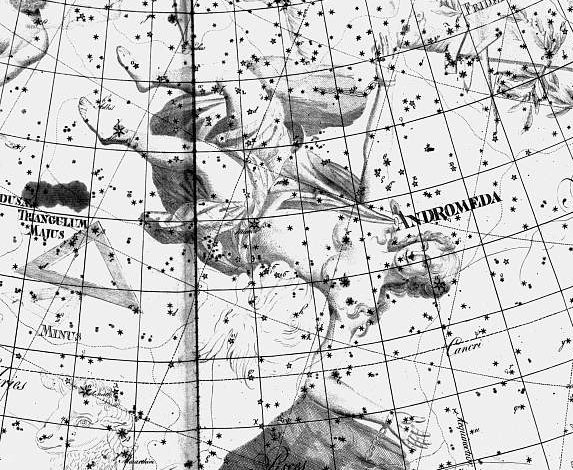The first star in Andromeda is
'the little egg',
οmikron. In rongorongo times the Sun rose
with ο Andromedae in RA day 348.9, which is
conspiciously early:

|
¬
Pu
Pakakina A Ira
®
|
 |
 |
 |
 |
|
Ga4-16 |
Ga4-17
(100) |
Ga4-18 |
Ga4-19 |
|
ν Hydrae
(163.1) |
no star
listed (164)
Altair
|
Wings-27 |
ANA-TIPU |
|
ALKES
(165.6) |
Merak
(166.2),
DUBHE
(166.7) |
|
Hora Iti 31 (243) |
Hora Nui
1 (*164) |
2 |
3 |
|
ºAugust
27 |
28 (240) |
29
(*161) |
30 |
|
'August
4 (216) |
5 (*137) |
6 |
7 |
|
"July 21
(*122) |
22 (22 /
7) |
23 (204) |
24 |
|
λ Pegasi (345.0), ξ
Pegasi (345.1), τ Aquarii (345.7), μ Pegasi (345.9) |
ι Cephei (346.0), λ
Aquarii, γ Piscis Austrini, σ Pegasi (346.5) |
Scheat Aquarii (347.0),
ρ Pegasi (347.2), δ Piscis Austrini (347.4),
Fomalhaut (347.8) |
Fum al Samakah (348.3),
ο Andromedae (348.9) |
|
March 1
(426 - 366 = 60) |
2 (427 -
81 = *346) |
3 |
4 (63) |
|
ºFebr 27
(*341) |
28 |
29 (424) |
ºMarch 1
(60) |
|
'February 3 (399) |
4 (*320 = *346 - 26) |
5 (36) |
6 |
|
"January
20 |
21
(*306) |
22 |
23 (388) |
Next 'star' - ca 6 nights later - was the Snowball
Nebula:
|
¬
Pu Pakakina A Ira
® |
 |
 |
|
Ga4-26 |
Ga4-27 (110) |
|
ο¹ Centauri
(173.8) |
ξ Hydrae
(174.3), ο² Centauri, λ Centauri (174.8) |
|
Hora Nui 10 (*173) |
11 (254) |
|
ºSeptember 6
(*169) |
7 (250) |
|
'August 14
(*146) |
15 (227 =
254 - 27) |
|
"July
31 (212) |
"August 1
(*133) |
|
Snowball
Nebula (355.0) |
no star listed (356) |
|
March 11 (*355 = 435 - 80) |
12 (71 = 436
- 365) |
|
ºMarch 8 (67
= 31 + 28 + 8) |
9 (*352) |
|
'February 13
(409) |
14 (45) |
|
"January 30
(*315) |
31
(396) |
Its
declination (42° 33′
N) is markedly close to that of οmikron (42° 20′
N)
The remaining newly listed Andromeda objects
came later, not in glyph line Ga4. But it should be
noted that the first glyph in line Ga5 very well could refer to
ι Andromedae:
| ¬ Pu Pakakina A Ira
® |
 |
 |
 |
|
Ga5-1 (111) |
Ga5-2 |
Ga5-3 (*177) |
|
θ Crateris
(175.0), ω Virginis (175.3), ι Crateris (175.5) |
ο Hydrae
(176.1) |
ζ Crateris,
ξ Virginis (177.0), λ Muscae (177.1), ν Virginis
(177.2), μ Muscae (177.8) |
|
Hora Nui 12 |
13 (256 =
172 + 84) |
14 |
|
ºSeptember 8
(251) |
9 (*172) |
10 |
|
'August 16
(*148) |
17 (229) |
18 |
|
"August 2 |
3
(*135) |
4 (216) |
|
ι Phoenicis (357.3), ι
Piscium (357.4), λ Andromedae (357.9) |
λ Piscium (358.0),
Manus Catenata (358.1), Alrai, θ
Phoenicis (358.4), κ Andromedae (358.7) |
ω Aquarii (359.2) |
|
March 13 |
3-14 (73) |
15 (*359) |
|
ºMarch 10 |
11 (70) |
12 (*355) |
|
'February 15
(46) |
2-16 (*332) |
17
(413) |
|
"February
1 (32) |
2 (*318) |
3
(399) |
Its name was Manus Catenata - 'The Chained
Hand'. In rongorongo times Manus Catenata rose with the Sun in
March 14 (3-14).
Another
name for ι Andromedae was Keff al
Salsalat, which probably meant the same in Arabic. A chained hand is a hand which does not move - spring had not
yet arrived.

Earth and Sky were still in 'close embrace' -
possibly illustrated by henua open at the top in Ga5-3,
which should be compared with the same type of Sign in Ga4-13:
|
Te Pito O
Te Kainga A Hau Maka |
Pu
Pakakina A Ira
®
|
 |
 |
 |
|
Ga4-13 |
Ga4-14 |
Ga4-15 (98) |
|
φ Hydrae
(160.3) |
no star
listed (161) |
Vathorz
Posterior (162.1), Peregrini, η Carinae (162.6) |
|
Hora Iti 28 |
29 |
30 (242) |
|
ºAugust 24
(236) |
25 (237) |
26 |
|
'August 1 |
2 (214) |
3
(*135) |
|
"July 18 |
19 (200) |
20 |
|
ε Piscis Austrini (343.5), ο
Pegasi (343.8) |
Matar (344.2) |
Leap night |
|
February 27
(58 = 2 * 29) |
28 (*344) |
29 (60) |
|
ºFebruary 23
(54) |
24 (*340) |
25 (421) |
|
'January 31 (396) |
'February 1 |
2 (33) |
|
"January 17 |
18 (383) |
19 (384) |
|











